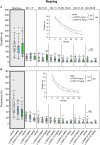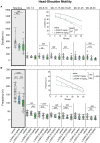Relationship Between L-DOPA-Induced Reduction in Motor and Exploratory Activity and Striatal Dopamine D2 Receptor Binding in the Rat
- PMID: 26778989
- PMCID: PMC4701934
- DOI: 10.3389/fnbeh.2015.00352
Relationship Between L-DOPA-Induced Reduction in Motor and Exploratory Activity and Striatal Dopamine D2 Receptor Binding in the Rat
Erratum in
-
Corrigendum: Relationship Between L-DOPA-Induced Reduction in Motor and Exploratory Activity and Striatal Dopamine D2 Receptor Binding in the Rat.Front Behav Neurosci. 2016 Mar 15;10:36. doi: 10.3389/fnbeh.2016.00036. eCollection 2016. Front Behav Neurosci. 2016. PMID: 27013999 Free PMC article.
Abstract
Purpose: The present study assessed the influence of L-DOPA administration on neostriatal dopamine (DA) D2 receptor binding in relation to motor and exploratory behaviors in the rat.
Methods: D2 receptor binding was measured in baseline, after challenge with the aromatic L-amino acid decarboxylase inhibitor benserazide, and after challenge with either 5 or 10 mg/kg L-DOPA plus benserazide. Additional rats received injections of saline. For baseline and challenges, striatal equilibrium ratios (V[Formula: see text]) were computed as estimation of the binding potential. Motor and exploratory behaviors were assessed for 30 min in an open field prior to administration of [(123)I]IBZM. D2 receptor binding was measured with small animal SPECT 2 h after radioligand administration for 60 min.
Results: Both L-DOPA doses significantly reduced D2 receptor binding relative to baseline and led to significantly less ambulation, less head-shoulder motility, and more sitting relative to saline. Moreover, 10 mg/kg L-DOPA induced less head-shoulder motility, more sitting, and more grooming than 5 mg/kg L-DOPA. Analysis of time-behavior curves showed that L-DOPA-treated animals relative to saline exhibited a faster rate of decrease of ambulation frequency and a slower rate of decrease of both duration and frequency of head-shoulder motility from a lower maximum level.
Conclusions: The reductions of striatal D2 receptor binding after L-DOPA may be conceived to reflect elevated concentrations of synaptic DA. L-DOPA-treated animals showed less ambulation and less head-shoulder motility than saline-treated animals, indicating an association between less behavioral activity and increased availability of striatal DA. The faster rate of decrease of ambulation frequency and the lower maximum levels of both head-shoulder motility duration and frequency may be interpreted in terms of influence of increased DA availability on behavioral habituation to a novel environment.
Keywords: D2 receptor; L-DOPA methylester; [123I]IBZM; exploratory behavior; habituation; motor behavior; small animal SPECT; time-behavior curves.
Figures









References
-
- Boissier J. R., Simon P. (1966). [On the potentiation of DOPA effects by monoamine oxidase inhibitors]. Psychopharmacologia 8, 428–436. - PubMed
-
- Bryson G., Bischoff F. (1971). A scatter-jump syndrome with gnawing and fighting induced by L-dopa in mice. Res. Commun. Chem. Pathol. Pharmacol. 2, 469–476. - PubMed
LinkOut - more resources
Full Text Sources
Other Literature Sources

